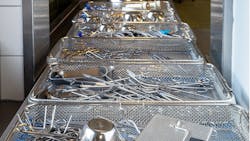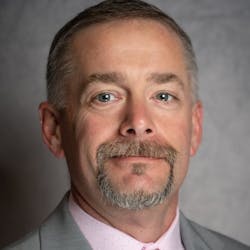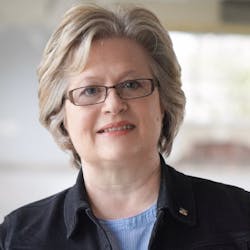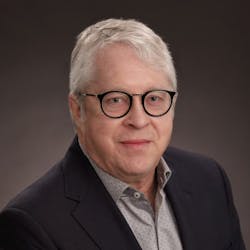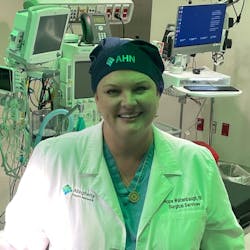Shifting strategies and sites for reprocessing success
When it comes to sterile processing (SP), location matters, whether it is on-site, off-site, or centralized to one location. Industry experts share their insights on factors driving healthcare organizations to rethink their reprocessing strategies, trends in reprocessing location across acute and non-acute facilities, and tips for determining an optimal approach that supports safe and effective patient care.
Drivers of change
Inadequate space, limited instrument and device inventories, cost pressures, staffing issues, compliance failures—these are just some of the reasons why health systems and hospitals are reassessing their SP department structures and sites.
“This shift is often prompted by challenges such as ensuring proper compliance across multiple sites, addressing staff and leadership shortages, limited space in existing locations, and the financial implications of eliminating redundant, underutilized, or overutilized equipment. Many, if not all, of these factors are compelling organizations to reassess their infrastructure and better align with current and anticipated future needs.”
Room to grow
For some health systems, a change in reprocessing location is prompted by growing patient populations and the need to accommodate their care, noted Angela Carranza, Manager of Clinical Resources, Medline.
“One common theme that we do see is that by using a centralized and often off-site location, prime real estate within the healthcare institution is freed up,” said Drosnock. “In the acute-care setting, this may mean that more operating rooms could be installed, which would create additional revenue for the facility.”
A ‘systemness’ to SPD
“The idea of thinking holistically about the health system and how the entities within the system work together continues to become more prominent. In my opinion, both the cost of construction and the difficulties finding staffing for many locations are the big drivers to thinking about the consolidation of reprocessing locations. Moving to centralizing reprocessing isn’t the right answer for all health systems, and there are many areas to consider: availability of space, future growth plans, current ‘systemness’ of SPD, technology, etc. But completing an evaluation to determine if it’s an idea to pursue is a valuable effort for the health system.”
All options are on the table
He stated, “The drivers are usually financial, capacity for growth, and quality-compliant outcomes but the final decisions are unique to each situation. Centralizing reprocessing continues to be a common outcome when the physical ability exists with reasonable financial investment. For many, this means centralizing in an existing hospital’s SPD, while others located in high-population and dense geographies often consider off-site reprocessing centers (ORC). Many often choose a combination of both options.”
Facilities seeking design assistance with their reprocessing space can use Torvan Medical’s Floorplanner software, a free tool offered on the company’s website. According to Brown, all that is required is the floorplan for the department. From there, the user can add walls, windows, and doors, and drag-and-drop different models of equipment used within the department: sinks, casework, mobile tables, countertops, pass-throughs, washer/disinfectors, sterilizers, cabinets, workstations, carts, etc.
“Once a 2D version is complete, that can be turned into a 3D image that can be rotated 360 degrees to get a full view, and then finally as a full rendering to give a life-like view of the finished product,” said Brown. “The departments that have used this have found it very helpful in making their final decisions on final products and workflow.”
Trends in non-acute facilities
Stuart said there is a significant trend toward consolidating and centralizing non-acute areas into a single reprocessing site.
He stated, “Clinic support has been consolidated into acute facilities for their respective clinics, and there is a growing consideration to include them in centralized locations as well. A smaller proportion of organizations are investing in or, at the very least, exploring the feasibility of centralizing multiple sites into a single location or a completely off-site center.”
“We see a variety of different ways that facilities are handling the reprocessing of devices in the non-acute setting,” said Drosnock. “If they are part of a healthcare system, like an ambulatory care facility associated with hospital, and that hospital implements a centralized processing area, then their devices may be transported to that central location. Or they may go directly to the main hospital to sterile processing.”
“That being said, it is still very common to see the non-acute settings reprocessing their own instruments,” she added. “If they are associated with the healthcare system, often infection prevention (IP) will come and survey their processing areas or sterile processing may even do so. In my opinion, these areas should be looked at by IP and sterile processing management of the healthcare system. According to ST 79 and ST 91, we want to implement standardization across our different facilities for processing. So, they should be brought under that umbrella.”
According to Carranza, the size of a health system plays a role. She stated, “For example, we see a blend of on-site and off-site reprocessing with hospitals that have multiple clinics or multiple procedure areas. An independent, acute-care facility that does not have other partnering facilities tends to reprocess just for their needs, whereas an acute-care facility within a health system may support the processing of their off-site clinic procedural areas.”
“As health systems have integrated clinics into their operations over the past decade, many of them have centralized instrument reprocessing within their nearby hospital SPDs using courier services,” noted Kimsey.
He described the drivers behind this move, “The clinics were typically not staffed nor physically compliant to perform the proper reprocessing tasks. With an increase in inventory to allow for 24-hour turnaround of their instruments, the move to centralization was usually a simple move. Often though, the clinics do not have the adequate budget to purchase the additional inventory inhibiting their ability to centralize.”
Trends in ambulatory surgery centers (ASC)
Stuart pointed out how the ambulatory surgery center (ASC) market is diverse, with freestanding and hospital-operated ASCs providing different models to leverage resources within the market. He explained how these models play a role in how they structure reprocessing:
“Hospital-owned or planned facilities can be included within projection planning, offering additional ROI and flexibility for surgical growth while maintaining reprocessing standards. In contrast, freestanding or doctor-owned facilities tend to adhere to the traditional model of on-premises reprocessing due to their inability to leverage volumes within a given market.”
In Carvill’s experience, most ASCs continue to maintain their reprocessing on-site, but some are turning to third-party off-site reprocessing services to support growing case volumes.
“This has been pressure-tested though in recent years with the push of orthopedics, joint and spine procedures to the ASC setting,” she noted. “ASCs designed and built for the traditional ‘small procedure’ workloads are now realizing they have inadequate-sized SPDs for the higher-acuity surgical cases being performed by their surgeons. I don’t believe we’ve seen an industry agreement yet on how ASCs are going to handle the reprocessing requirements.”
“In some markets and health systems, ORCs have been utilized to help alleviate and decompress their SPD requirements,” Carvill added. “The use of ORCs has allowed them to expand their surgical procedures. In other situations, ASCs are looking within their own health system for reprocessing solutions. The final solution may end up a hybrid with reprocessing performed both in the ASC and off-site for specific instrumentation such as vendor trays.”
Trends in endoscope reprocessing
The impactful changes in endoscope reprocessing guidance contained within ANSI/AAMI ST91:2021, Flexible and semi-rigid endoscope processing in healthcare facilities, have prompted health systems and hospitals to reevaluate where they reprocess scopes, who performs reprocessing, and whether they have the necessary equipment to do it in accordance with the standards.
“Endoscope reprocessing has been a focal point for several years due to the complexity of reprocessing, the high cost of devices, and advancements in mechanical cleaning,” said Stuart. “High-volume locations often reprocess within the unit, employing specialized staff and equipment.”
Drosnock comments on how ANSI/AAMI ST91:2021 should drive greater standardization of endoscope reprocessing practices across health systems:
“In general, with the release of the new endoscope national standard, ST 91, from AAMI, we see that endoscope processing practices are improving. But we have a long way to go. Often, ambulatory locations are not following AAMI standards and therefore, may be processing to a different standard of care than SPD or the endoscopy department in the hospital setting. Again, ST 91 recommends standardization of practices across the different settings within an organization. So, as part of the risk assessment for endoscope processing, and the overall endoscope processing policy for the system, standardization should be a goal.”
For Darville, performing endoscope reprocessing in the vicinity of where endoscopy procedures take place improves efficiency and supports on-time case starts, as opposed to reprocessing scopes in the SPD, which necessitates transport to/from procedural areas.
“Reprocessing scopes in the SPD means having to coordinate reprocessing times with patient cases for the day to ensure clean and sterilized scopes are available when needed,” said Darville. “Then there are issues with preventing scope recontamination. SPD and endo are cousins—related but require two separate processes. While you can reprocess scopes in the SPD with another instrumentation, there is always the risk of cross-contamination.”
“There is an increased risk for damage as well,” Darville added. “With starting prices for endoscopes upward of $40k, we want to protect these assets. Keeping the entire endoscope department separate, including reprocessing, can help us avoid these issues.”
“We are definitely seeing a consolidation of endoscope and high-level disinfection to centralized locations within hospitals and health systems,” said Kimsey. “The international attention to the difficulties in cleaning scopes, and resulting negative patient outcomes, pushed the industry to improve both the scope design as well as the health system’s ability to effectively clean and reprocess the scopes. Some health systems have chosen to centralize within their SPDs if they are able to handle the volume with the required equipment while others have either created a centralized scope center and/or utilized their existing endo reprocessing area.”
“For many though, their physical environments are not conducive to centralization while meeting IFUs and ST91 requirements, and thus, find themselves considering alternatives,” he added.
Scope reprocessing off-site
“I haven’t worked with any hospitals taking all endoscope reprocessing off-site, but I have seen more hospitals looking to centralize high-level disinfection (HLD) to a few select locations across the hospital instead of a very distributed HLD model,” said Crowe. “This has allowed hospitals to have more control over the process and the validity of the processing being done.”
“Some consolidation has been observed within a facility or among closely connected facilities,” said Stuart. “However, due to the significant expense associated with inventory, there has been little to no adoption of centralization strategies that require transportation over long distances of flexible endoscopes.”
“Off-site reprocessing of scopes remains a more difficult solution but collaboration with the OEMs and others are developing to address and provide a compliant solution,” said Kimsey. “Health systems fortunate to be building new reprocessing areas have the best opportunity to centralize their flexible scope processing in properly designed three-room flow departments with pass-through AERs, liquid sterilization, and/or low-temperature sterilizers.”
Device type impact on reprocessing
Reprocessing strategy and location should also consider the type of instruments and devices involved. The constant struggle between risk and cost in healthcare, combined with ongoing staffing issues, translates into tough decisions on choosing single-use or reusable products.
To improve reprocessing efficiencies and drive optimization in off-site clinic procedural areas, Carranza said it’s crucial to evaluate disposable instrumentation options.
“While SP professionals are the subject matter experts in the core foundation of decontamination, disinfection, and reprocessing, taking on added reprocessing responsibility across multiple areas within their acute facility plus off-sites, can lead to increased costs in labor, transport, along with generalized inefficiencies when servicing core areas, such as the OR.”
“By analyzing your instrument tracking data, you can uncover high-reprocessed instrument trays that are not physician-referenced,” she added. “These trays are great options to move to disposable instruments for the off-site, non-acute physician clinics. This analysis can help alleviate the pressure in the SPD to improve efficiencies for the OR-specific instrument reprocessing.”
“These products obviously need to be moved from on-site reprocessing to reprocessing by a company that has FDA clearance to reprocess,” Thording noted. He described how many reusable products are being moved off-site as well:
“Hospitals are increasingly recognizing that SPD’s limitations can mean Joint Commission requirements are compromised if reusable devices are reprocessed on-site. Reusable connector cables are a good example. Most connector cables are reprocessed on-site, but different manufacturers’ cables come with very different IFUs that imply different cleaning requirements and different numbers of cycles. Should the Joint Commission see devices with different IFUs treated with the same process in on-site reprocessing, the hospital could face some grim oversight situations. Add to this that connector cables vary in number of uses, but most SPDs do not have the ability to track number of uses, and consequently, cables are simply used until they fail – with substantial regulatory, patient risk, and operational costs involved.”
“Among our partner hospitals, we have seen up to 40 percent transition in their cable-reprocessing activities off-site, where they can be cleaned according to IFUs, tested before use, and discontinued when hitting max cycle,” Thording added.
Four key factors for reprocessing site success
“I am a firm believer that there’s no one-size-fits-all solution for reprocessing,” she stated.
Here are her four recommended key factors for consideration when considering a shift in reprocessing strategy.
1. Specialty: “Think about the specialties and procedures your SPD team will be supporting and providing for, that will dictate your reprocessing site requirements. Consider tray size, inventory, and instrument complexity. For example, reprocessing loaner trays for neuro, spine or total joint cases is very different from reprocessing a simple pain clinic foot tray.”
2. Logistics: “Whether you are thinking about centrally processing in one location or building an off-site center, it’s all about logistics. If you go off-site and don’t have a transport plan, the project could bomb. Be sure to consider traffic and its impact on transporting trays. Your centralized reprocessing location might be in a 12-mile radius of the sites it serves, but if there are six school districts in that area, your drivers will have to contend with 7 a.m. and 3 p.m. school bus traffic.”
3. Staffing: “While healthcare organizations budget for reprocessing equipment, they often don’t budget for full-time employees (FTE) to run their sterile processing operations. Think of a facility renovating its existing SPD or building a new one to accommodate growing volumes but it only has 10 FTEs to handle all the extra work. Or one that is building an off-site reprocessing center but hasn’t budgeted for the additional Environmental Services (EVS) employees to clean it. Resource planning and budgeting is critical to success.”
4. A multidisciplinary approach: “A multidisciplinary team can make or break any reprocessing initiative. You need a champion in each function who will advocate for the project and support it all the way through.” Here are the stakeholders Walters recommends engaging from the beginning:
· Budget and finance
· Infection control (IC) or prevention
· Surgeons or other physicians who are provided for
· Quality or risk management
· Sterile processing professionals, leaders, and frontline workers
Allegheny Health Network’s offsite SPD supports surgical volume growth
Allegheny Health Network (AHN) is a Pittsburgh-based nonprofit health system with 14 hospitals and nine surgery centers. An assessment by its sterile processing (SP) equipment provider STERIS found SP operations at its flagship Level 1 trauma hospital, Allegheny General Hospital (AGH), were over capacity.
STERIS delivered a Mobile Sterile Processing Unit to the AGH campus and built a semi-permanent reprocessing center around it. Within a week of opening, the offsite center processed over 200 trays.
Based on a STERIS assessment of AGH’s trays, the health system was able to remove unnecessary items, so they had fewer to reprocess. This freed up capacity in the offsite center so the health system could reprocess trays from its ambulatory surgery centers (ASC) there as well.
“Because the ASCs are such small spaces, it’s challenging for them to manage trays for total joints and robotics,” noted Waltenbaugh. “Moving these trays to the offsite gave them the opportunity – and room - to grow these more complex cases.”
Waltenbaugh described how the offsite has become their “savior” during crisis situations:
“We had to shut down an SPD at one of community hospitals for eight weeks to replace an air handler. By moving this facility’s trays to the offsite center, we didn’t have to cancel a single surgery. We also had an emergency last summer where a humidity issue compromised all packs and trays in another SPD. We off sited it all and within one week had over 2,000 trays sterilized. In both situations, without the offsite reprocessing center we would’ve been shut down for weeks.”
Waltenbaugh’s advice to other health systems when considering this approach to reprocessing:
“There is a cost, so organizations must weigh that cost against the benefits. What is the price of having perfect surgical trays, on-time for surgical procedures?”
About the Author
Kara Nadeau
Senior Contributing Editor
Kara Nadeau is Sterile Processing Editor for Healthcare Purchasing News.
